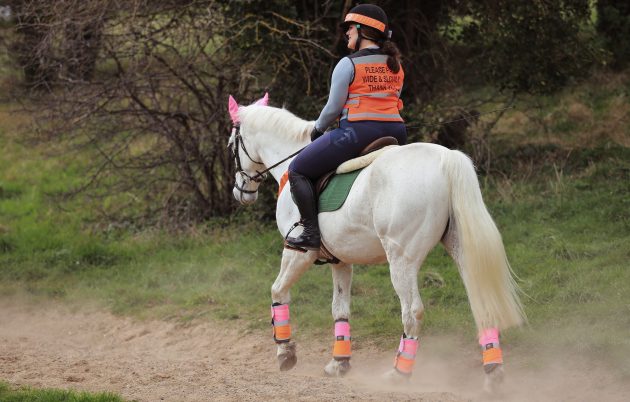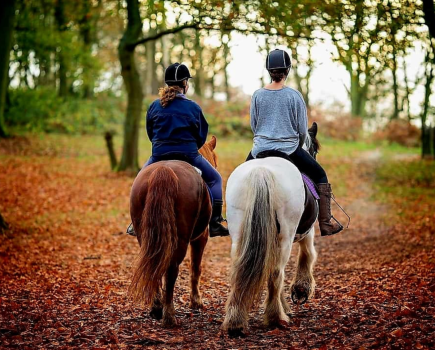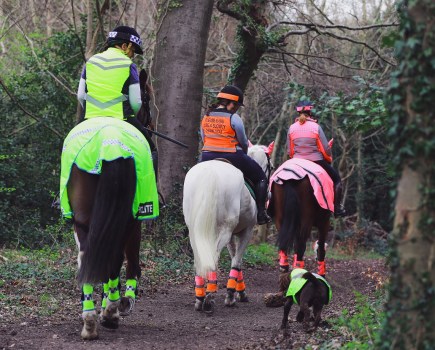In partnership with Equisafety…
Hacking is one of the joys of riding horses — that’s why we’ve challenged riders to #Hack1000Miles. Group hacking is great fun, but it’s likely that sometimes you’ll need to go out alone. This requires a confident horse and rider, with a trusting relationship. Australian horseman Jason Webb, of Your Horsemanship, shares his advice for hacking alone.
1 Think like your horse
As herd animals, horses rely on their friends for safety, companionship, grooming and warmth and it can be really daunting to leave them behind to join you on a hack. Other reasons include having a sheltered young life, a bad hacking experience in the past, or being scared of new experiences. The answer lies in him becoming confident in you and seeing you as a leader. If he hasn’t got this, he’ll look to his friends instead.
2 Take the lead
Hacking out with others and taking the lead is a confidence-boosting way of dealing with the issue. Get fifty yards in front and stay there. Your horse will know he’s not alone and will most likely not mind taking responsibility for leading. From here, progress to hacking with a friend walking alongside or on a push bike.
3 Take baby steps
Don’t set goals that are too big as you’ll hate the journey of getting there and pushing yourself into frightening situations isn’t helpful. When it’s time to hack alone, find a very short, circular ride. Pick a point in the distance and ride to it, focusing on it the whole way. This will keep your energy channelled and your horse will feel it too, resulting in him thinking forward.
You don’t need to go far, even 50 metres with no fuss is a big achievement. Carry a phone and have a friend on hand who you can call if you get stuck.
4 Manage your mindset
Riders can easily get caught up in the ‘what if?’ of riding, conjuring up images of the disasters that may be about to strike. Having a plan that you’ve practiced will help. For instance, if you or your horse has a wobble when you’re out, can you get off and on again? Do you need to train at home to make sure? The more prepared you are, the less scary it becomes, and your horse will benefit from your new-found boldness too.
5 Tackle nappy behaviour
Spinning, planting, rearing and running backwards to avoid leaving the yard are classic signs of nappiness. This can be caused by rider tenseness – are you hanging on and restricting him? If yes, ride in the arena or a secure field at the yard and encourage your horse into a free-flowing canter. Don’t hold on, just direct. This should be a positive, forward experience.
If you do get stuck at the yard gate, use your leg as much as necessary but as little as possible and tap with the whip behind the saddle too. Try for one step at a time, using the energy created to get more if you can. He has to know you’re prepared to use your legs. Decide how far you want to get that day, and ride for that.
6 Jogging home
If your horse is desperate to get home and he speeds up when you’re heading in that direction, ride him forward and turn a half a circle until you’re riding away from home. You will need to nee clear with your leg aids that this is what you want him to do. When he relaxes, after a few moments you can turn for home again. If he speeds up, repeat the circle exercise, keeping your leg on to push him around. Being consistent in your approach will make the difference.
Top tips
- If you are nervous, ask someone experienced to ride your horse solo initially. He will need a confident rider on his back to draw confidence from.
- Reassure your horse when he does as you ask: this might be praise with your voice, a pat, a scratch of the withers — whatever you know he likes and responds well too.
- When hacking solo, always carry a charged mobile phone with an app like What3words installed and tell someone where you intend to ride and time to expect you home.
- Safety is as important as ever: make sure you are wearing a correctly fitting hat and high vis on both you and your horse.
Words by Julie Brown
This content is brought to you in partnership with Equisafety, high viz clothing for horses and riders.









